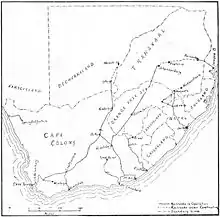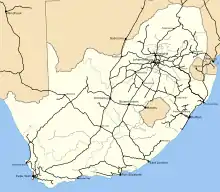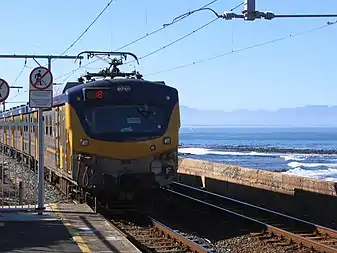Rail transport in South Africa
Rail transport in South Africa is an important element of the country's transport infrastructure. All major cities are connected by rail, and South Africa's railway system is the most highly developed in Africa.[1] The South African rail industry is publicly owned.
History

The first railway was from Cape Town to Wellington and was worked by a small locomotive in 1859. The first passenger carrying service was a small line of about 3.2 kilometres (2 mi) built by the Natal Railway Company, linking the town of Durban with Harbour Point, opened on 26 June 1860.[2] Cape Town had already started building a 72-kilometre (45 mi) line, track gauge 1,435 mm (4 ft 8 1⁄2 in), linking Cape Town to Wellington in 1859 but was hampered by delays and could only begin passenger service to the first section of the line to the Eerste River on 13 February 1862. However Cape railway construction began a massive expansion, after the formation in 1872 of the Cape Government Railways.[3]
In the north, in the independent South African Republic, railway construction was done by the Netherlands-South African Railway Company (NZASM), which constructed two major lines: one from Pretoria to Lourenço Marques in Portuguese East Africa Colony, and a shorter line connecting Pretoria to Johannesburg. A national "link-up" was established in 1898, creating a national transport network.[4] This national network was largely completed by 1910.[1] Though railway lines were also being extended outside of South Africa, as far north as Northern Rhodesia (present-day Zambia),[5] the vision of Cecil John Rhodes, to have a rail system that would run from the "Cape to Cairo", would never materialise.

Upon the merger of four provinces to establish the modern state of South Africa in 1910, the railway lines across the country were also merged. South African Railways and Harbours (SAR & H) was the government agency responsible for, amongst other things, the country's rail system.
Electrification of the railways began in the 1920s with the building of the Colenso Power Station for the Glencoe to Pietermaritzburg route and the introduction of the South African Class 1E.[6]
During the 1980s, the transport industry was reorganised. Instead of being a direct government agency, it was modelled along business lines into a government-owned corporation called Transnet. Transnet Freight Rail (until recently known as Spoornet) is the division of Transnet that runs the rail system.[7] Though there are no plans to end government-ownership of the national rail network, some small portions of the rail system have recently been privatised.[8]
Network

Two different public companies operate freight and commuters services: Transnet Freight Rail and PRASA respectively. Transnet Freight Rail is the largest division of Transnet, a State Owned Company (SOC), wholly owned by the Government of the Republic of South Africa and is the custodian of rail, ports and pipelines.
The commuters' network is divided into urban and long distance routes. Metrorail, the urban commuter transport service present in Gauteng, Western Cape, KwaZulu-Natal and Eastern Cape, is responsible for transporting up to 2 million passengers daily. Shosholoza Meyl operates long distances routes covering the major metros in the country: Johannesburg, Cape Town, Durban, Port Elizabeth and East London on a weekly basis. Shosholoza Meyl offers tourist class and premier classe. In addition to these services, the Blue Train is a luxurious passengers rail line and a popular tourist attraction for South Africa [8], which runs from Cape Town to Pretoria. It was the winner of the most luxurious train in Africa for the tenth consecutive year in 2019, and the three-time winner of the world’s most luxurious train at the World Travel Awards. The Blue Train however, is operated by Transnet Freight Rail.
With the increasing coverage provided by the nation's highway system, long-distance passenger travel has declined in South Africa. While many commuters still use rail for their daily commute, nationally, only half of the nation's 36,000 kilometres (22,000 mi) of track is being fully utilised, and some 35% of the nation's track carries no activity or very low activity.[1] Accordingly, Transnet is moving towards an emphasis on freight, rather than passengers, to keep the rail system profitable.
For a look at the South African transport network, including the railways, view this map from the United Nations.
A high-speed rail link has been proposed, between Johannesburg and Durban.[9]
Specifications
Nearly all railways in South Africa use a 1,067 mm (3 ft 6 in) Cape gauge track.[10][11][12] This was selected in the 19th century to reduce the cost of building track across and through the mountains found in several parts of the country.[8] The Gautrain rapid transit railway uses 1,435 mm (4 ft 8 1⁄2 in) (standard gauge).
During the late 19th century and the early 20th century numerous 2-foot narrow gauge railways were constructed.
South African trains connect through the AAR coupler, developed in the United States at the end of the 19th century. Remarkably, though South Africa has long been ahead of Europe in coupling systems, it has lagged behind most of the world in its braking system; most trains in South Africa continue to use vacuum braking. However, the conversion to air brakes has finally commenced.
Between 50% to 80% of the rail lines in South Africa are electrified.[8] Different voltages are used for different types of trains. Most electrified trains run 3000 V DC (overhead); this is used primarily for commuter lines, and has been in use since the 1920s. During the 1980s, higher voltages (25 kV AC and—much less frequently—50 kV AC (both overhead) have been used for heavy duty lines (which also require more sleepers per kilometer) primarily used for the transport of iron ore.
Rolling stock
South Africa uses a variety of rolling stock from a number of manufacturers.
In 1957 Union Carriage & Wagon was founded in Nigel for local production of rolling stock.[13]
Accidents and incidents
- 19 February 1896, a freight train loaded with eight trucks of dynamite was struck by a shunter while unloading. The resulting Braamfontein Explosion was one of the largest artificial non-nuclear explosions in history, killing more than 70 people, and injuring over 200.
- 2 February 2002, 24 people died in the 2002 Charlotte's Dale train collision
- 26 October 2005, 2005 Deelfontein train collision, head-on collision between the Blue Train and the Trans Karoo
- 13 November 2006, Faure level crossing accident, 19 people were killed at a level crossing near Somerset West when a metrorail train collided with a truck carrying farm workers.[14]
- 21 April 2010, 3 crew died in the Pretoria runaway of a Rovos Rail train
- 25 August 2010, Blackheath level crossing accident, 10 children died as a result of a level crossing crash between a Metrorail commuter train and a minibus taxi.
- 13 July 2012. Hectorspruit level crossing accident, at least 25 people were killed at a level crossing near Hectorspruit, Mpumalanga, when a coal train collided with a truck carrying farm workers.
- Saturday, 18 July 2015. Johannesburg train crash: Two commuter trains collided and overturned in Johannesburg. ~200 people were injured.
Rail systems in nearby countries
The following countries mostly use 1,067 mm (3 ft 6 in) gauge and are mostly connected together. Countries beyond those listed are of other gauges.
- Angola
- Botswana
- Republic of the Congo – isolated
- Democratic Republic of the Congo – half isolated
- Lesotho
- Malawi
- Mozambique (Pretoria–Maputo railway), under repair
- Namibia
- Swaziland
- Tanzania same gauge as far as Dar es Salaam –
transshipment to 1,000 mm (3 ft 3 3⁄8 in) gauge at Kidatu - Zambia
- Zimbabwe
Further reading
- The South African Railways – History, Scope and Organisation. South African Railways Public Relations Department. June 1947.
- Bullock, Richard (November 2009). AICD Background Paper 17 – Off Track: Sub-Saharan African Railways (PDF). Washington, DC: The International Bank for Reconstruction and Development / The World Bank.
See also
- Two foot gauge railways in South Africa
- Avontuur Railway
- Cape Government Railways
- Cape gauge
- Flying Dutchman Funicular
- Kei Rail
- Metrorail
- Natal Government Railways
- Netherlands-South African Railway Company
- Shosholoza Meyl
- South African locomotive history
- Transport in South Africa
- Passenger Rail Agency of South Africa
- Transnet
- Rovos Rail
- Gautrain
References
- South Africa – ICOMOS World Report on Monuments and Sites in Danger 2002: Heritage @ Risk
- Talbot, Frederick Arthur Ambrose. Railway wonders of the world. Cassell and Company. p. 606.
- Burman, Jose (1984), Early Railways at the Cape, Cape Town: Human & Rousseau, ISBN 0-7981-1760-5
- SAR & Transnet History
- SA Railway History Archived 5 March 2008 at the Wayback Machine
- "South African Railways Power Plant". Electric Railway Journal. 60 (24): 914. 9 December 1922. Retrieved 15 September 2010.
- Spoornet history
- South Africa :: Railways and roads – Britannica Online Encyclopedia
- "Railway Gazette: Ambitious plans will still need funding". Retrieved 19 September 2010.
- "Freight Rail International Joint Ventures". Transnet – Freight Rail. Archived from the original on 26 November 2009.
- "Rail Engineering Wheels Business". Transnet – Rail Engineering. Archived from the original on 6 October 2008.
- "Railway Transportation in South Africa" (PDF). Global View. Archived from the original (PDF) on 29 December 2009.
- "History". Union Carriage & Wagon. Retrieved 2 July 2011.
- "Train crash death toll false, say police". Independent Online. Retrieved 18 November 2006.
External links
| Wikimedia Commons has media related to Rail transport in South Africa. |
